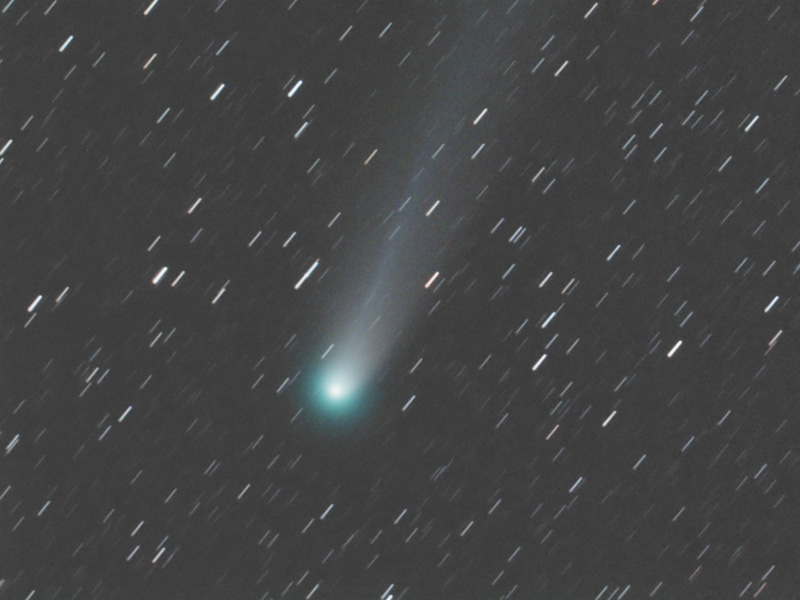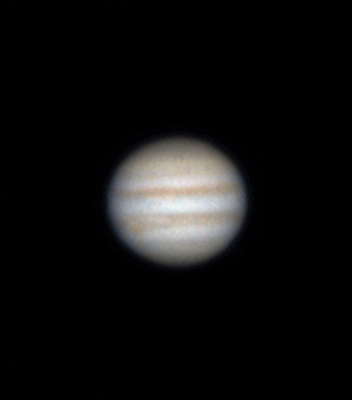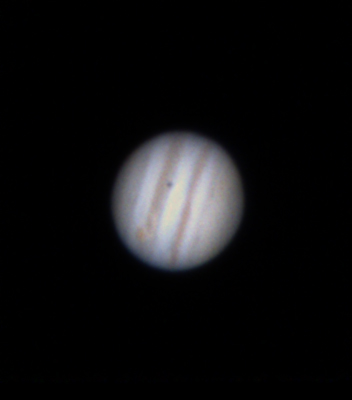Try increasing gamma if dark sections aren't distinguished
Monday, February 17, 2014
Saturday, February 15, 2014
Jupiter Overview
Jupiter is up for prime viewing this month so here's
an overview of the king of planets.
5th planet from the sun, largest, a gas giant covered with clouds.
The white clouds seen on the surface are thought to be ammonia crystals. Darker shades may be due to phosphorus, sulfur, or hydrocarbons stirred up from lower levels.
The great red spot is a persistent storm that's been visible for as long as we've been able to see it with telescopes.
Known as the amateur's planet because there's always something going on:
-the 4 bright Galilean moons rotate around the planet, sometimes casting shadows as they cross over the face, other times disappearing from view as they move behind Jupiter or its shadow, only to reappear hours later.
-the great red spot can be seen at times. the spot rotates with the clouds on the planet's surface coming into view every 10 hours
-a number of significant planetary events have been discovered by amateurs including major meteor strikes leaving transient spots on the surface, formation and disappearance of normally consistent bands, spots, etc.
Low power view with binoculars will show a disk with the 4 Galilean moons in various arrangements in a line around the planet. modest magnification with a telescope (60-80x) will reveal several cloud belts on the surface:
5th planet from the sun, largest, a gas giant covered with clouds.
The white clouds seen on the surface are thought to be ammonia crystals. Darker shades may be due to phosphorus, sulfur, or hydrocarbons stirred up from lower levels.
The great red spot is a persistent storm that's been visible for as long as we've been able to see it with telescopes.
Known as the amateur's planet because there's always something going on:
-the 4 bright Galilean moons rotate around the planet, sometimes casting shadows as they cross over the face, other times disappearing from view as they move behind Jupiter or its shadow, only to reappear hours later.
-the great red spot can be seen at times. the spot rotates with the clouds on the planet's surface coming into view every 10 hours
-a number of significant planetary events have been discovered by amateurs including major meteor strikes leaving transient spots on the surface, formation and disappearance of normally consistent bands, spots, etc.
Low power view with binoculars will show a disk with the 4 Galilean moons in various arrangements in a line around the planet. modest magnification with a telescope (60-80x) will reveal several cloud belts on the surface:
the face of jupiter typically has two prominent dark stripes across
the center along with grey/brown regions at the poles.
at higher magnification (100-200x) with good seeing and the right time you may see the Great Red Spot as well as smaller white ovals:
here's Europa and shadow crossing the face:
double, then rare triple shadow transit
One year, one of Jupiter's dark belts disappeared, returning several months later:
at one point, a second red spot appeared
here's red spot junior, barely visible at the tip of the arrow:
the slightly blue patches in the central white band are areas of clear sky, blue for the same reason ours is (i think):
a neat trick is to take two photographs of Jupiter 20 minutes apart. the rotation allows you to create a 3D pair:
at higher magnification (100-200x) with good seeing and the right time you may see the Great Red Spot as well as smaller white ovals:
here's Europa and shadow crossing the face:
double, then rare triple shadow transit
One year, one of Jupiter's dark belts disappeared, returning several months later:
at one point, a second red spot appeared
here's red spot junior, barely visible at the tip of the arrow:
the slightly blue patches in the central white band are areas of clear sky, blue for the same reason ours is (i think):
a neat trick is to take two photographs of Jupiter 20 minutes apart. the rotation allows you to create a 3D pair:
Friday, February 14, 2014
something red for valentine's
fair seeing last night
in time for a valentine's
shot of the GRS
20 minutes rotation:

stereo pair
put a paper between the two and view binocular style for a 3-D effect
in time for a valentine's
shot of the GRS
20 minutes rotation:
stereo pair
put a paper between the two and view binocular style for a 3-D effect
Sunday, February 9, 2014
Jupiter Callisto transit
seeing has improved from poor to mediocre
here's a bit better shot of Jupiter with moon Callisto and shadow transiting the face:
here's a bit better shot of Jupiter with moon Callisto and shadow transiting the face:
Sunday, January 12, 2014
the king is dead, long live the king...comet lovejoy
another comet of the century turned out to be a bust
but despite comet ISON's demise during it's pass by the sun
there's another comet out
while comet lovejoy is by no means comet of the century
it's one of the best comets i've been able to photograph from light polluted skies:
this one is fairly bright, but low in the sky
rises above my treeline at 15 degrees in the east at 5 AM, too bright to photograph by 6
so only had a narrow window to image it.
this is a stack of 20x2 minute exposures tracking on the head of the comet
which is moving relative to the stars, explaining the trails
here's an animation of the 20 individual frames aligned on the stars
showing the comet's motion (big file):
comet lovejoy motion
should remain fairly bright thru the month of january, rising higher in the sky
shame it's been overshadowed by ISON.
bill w
but despite comet ISON's demise during it's pass by the sun
there's another comet out
while comet lovejoy is by no means comet of the century
it's one of the best comets i've been able to photograph from light polluted skies:
this one is fairly bright, but low in the sky
rises above my treeline at 15 degrees in the east at 5 AM, too bright to photograph by 6
so only had a narrow window to image it.
this is a stack of 20x2 minute exposures tracking on the head of the comet
which is moving relative to the stars, explaining the trails
here's an animation of the 20 individual frames aligned on the stars
showing the comet's motion (big file):
comet lovejoy motion
should remain fairly bright thru the month of january, rising higher in the sky
shame it's been overshadowed by ISON.
bill w
Thursday, January 9, 2014
new year's sun spots, *solar winter storm warning tonight*
last year was the year of the solar maximum
peak in the 11 year cycle of sunspot activity
this is related to the sun's magnetic field flipping
water world with fire
which means this year is...
the year after the solar maximum
and still pretty good for solar activity so far.
took some relatively high power images of sun spots on new year's day:
there was some interesting activity just visible on the other edge:
the sun's surface rotates with a period of approximately 28 days when viewed from earth...
so here it is a few days later on 1/5/14 facing us:
 this was a big one which could be easily seen without magnification (looking thru filter)
this was a big one which could be easily seen without magnification (looking thru filter)
on 1/7/14 a coronal mass ejection was launched from this spot aimed right at us
as a result, tonight we're going to get hit by plasma consisting of charged protons, electrons, alpha particles and such...
which means major aurora activity tonight at the poles
there's a slight chance that you may see some activity if you live moderately far north
so take a look outside
you may see some strange lights
for more on this check out
http://www.spaceweather.com/
peak in the 11 year cycle of sunspot activity
this is related to the sun's magnetic field flipping
water world with fire
which means this year is...
the year after the solar maximum
and still pretty good for solar activity so far.
took some relatively high power images of sun spots on new year's day:
the sun's surface rotates with a period of approximately 28 days when viewed from earth...
so here it is a few days later on 1/5/14 facing us:
 this was a big one which could be easily seen without magnification (looking thru filter)
this was a big one which could be easily seen without magnification (looking thru filter)on 1/7/14 a coronal mass ejection was launched from this spot aimed right at us
as a result, tonight we're going to get hit by plasma consisting of charged protons, electrons, alpha particles and such...
which means major aurora activity tonight at the poles
there's a slight chance that you may see some activity if you live moderately far north
so take a look outside
you may see some strange lights
for more on this check out
http://www.spaceweather.com/
Monday, January 6, 2014
first light from new home: Christmas Jupiter
haven't imaged in about 6 months due to move/move/remodel... Jupiter is just past opposition now and should be in excellent position for viewing for the rest of January. Here's my first light image with a new camera from new location, Jupiter on Xmas night:
unfortunately, the seeing was terrible, amazed i was able to pull anything out at all. this is an animation of two shots taken about 30 minutes apart. shows the great red spot (lower left) just rotating into view.
here it is the next night (again terrible seeing)
you can see the great red spot lower left, Io's shadow upper mid, and a hint of Io just above and to the right of it's shadow.
cheers
unfortunately, the seeing was terrible, amazed i was able to pull anything out at all. this is an animation of two shots taken about 30 minutes apart. shows the great red spot (lower left) just rotating into view.
here it is the next night (again terrible seeing)
you can see the great red spot lower left, Io's shadow upper mid, and a hint of Io just above and to the right of it's shadow.
cheers
Subscribe to:
Posts (Atom)


















